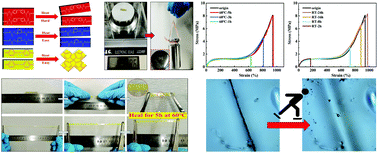Rapid self-healing and tough polyurethane based on the synergy of multi-level hydrogen and disulfide bonds for healing propellant microcracks†
Abstract
The advent of self-healing materials has promoted the development of some fields, and the market demand for self-healing materials has become increasingly vigorous. However, resolving the contradiction between mechanical performance and rapid self-healing ability is an urgent problem to be solved at present. Herein, we report a self-healing polyurethane containing multiple active hard segment structures, which can be fully restored to its original property within 5 h at 60 °C or 24 h at room temperature and has high strength mechanical properties of 8.0 MPa. Aromatic disulfide bonds and weak hydrogen bonds stimulate polyurethane to heal, and the strong hydrogen bond structure of the biphenyl ring ensures the overall strong mechanical properties. As a skeleton component of the propellant, the polyurethane can effectively restore 90% of the internal microcrack. This is of great significance for solving a series of problems caused by internal cracks in the propellant. In short, our work provides an important idea for the development of high-strength, fast self-healing materials, and verifies the feasibility of its application in the propellant.



 Please wait while we load your content...
Please wait while we load your content...